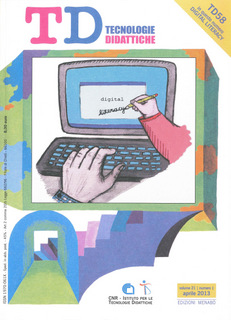Digital competence assessment as a complex competence in secondary education
Main Article Content
Abstract
Article Details
Section
Authors who publish with this journal agree to the following terms:
- Authors retain copyright and grant the journal right of first publication with the work simultaneously licensed under a Creative Commons CC BY 4.0 Attribution 4.0 International License.
- Authors are able to enter into separate, additional contractual arrangements for the non-exclusive distribution of the journal's published version of the work (e.g., post it to an institutional repository or publish it in a book), with an acknowledgement of its initial publication in this journal.
- Authors are permitted and encouraged to post their work online (e.g., in institutional repositories or on their website) prior to and during the submission process, as it can lead to productive exchanges, as well as earlier and greater citation of published work (See The Effect of Open Access)
References
Bennett S., Maton K., Kervin L. (2008). The ‘digital natives’ debate. A critical review of the evidence, British Journal of Educational Technology, 39 (6), pp. 775-786.
Calvani A., Fini A., Ranieri M. (2010). La competenza digitale nella scuola. Trento, IT: Centro Studi Erickson.
Calvani A., Fini A., Ranieri M. (2011). Valutare la competenza digitale. Prove per la scuola primaria e secondaria. Trento, IT: Centro Studi Erickson.
Cullen J. (2007). Status of e-inclusion measurement, analysis and approaches for improvement, Final Report. Brussels, BE: European Commission.
Degl’Innocenti R., Ferraris M.(1988). Il computer nell’ora d’italiano. Bologna, IT: Zanichelli.
Gui M. (2012). Uso di Internet e livelli di apprendimento. Una riflessione sui sorprendenti dati dell’indagine Pisa 2009. Media Education. Studi, ricerche, buone pratiche, 3 (1), pp.29- 42.
Hattie J. (2009). Visible learning: a synthesis of over 800 meta-analyses relating to achievement, London and New York: Routledge.
Jenkins H. (2009). Confronting the challenges of Participatory Culture: Media Education for the 21st Century, Cambridge, MA, USA.: MIT Press.
Jonassen D.H. (2009). Costruire modelli per costruire significato con i MindTools. In G. Marconato (ed.), Le tecnologie nella didattica. Trento, IT: Erickson, pp. 27-52.
Le Boterf G. (2000). Construire les competences individuelles et collectives. Paris, FR: Edition d’Organisation.
Margaryan A., Littlejohn A. (2008). Are digital natives a myth or reality? Students’ use of technologies for learning. http://www.academy.gcal.ac.uk/anoush/documents/DigitalNativesMythOrReality-MargaryanAndLittlejohn-draft-111208.pdf (ultima consultazione 22.08.2012).
OECD (2011). PISA 2009 Results: Students On Line: Digital Technologies and Performance, Volume VI. http://www.oecd.org/pisa/pisaproducts/pisa2009/pisa2009resultsstudentsonlinedigitaltechnologiesandperformancevolumevi. htm (ultima consultazione 22.08.2012).
Papert S. (1980). Mindstorms:Children, computers and powerful Ideas. New York, USA: Basic books.
Pellerey M. (2004). Le competenze e il Portfolio delle competenze individuali. Torino, IT: La Nuova Italia.
Ranieri M. (2011). Le insidie dell’ovvio, Tecnologie educative e critica della retorica tecno centrica. Pisa, IT: ETS.
Rivoltella P.C. (2012). Neurodidattica, insegnare al cervello che apprende. Milano, IT: Raffaello Cortina Editore.
Wiggins, G. P. (1993). Assessing student performance. San Francisco, USA: Jossey-Bass Publishers.

